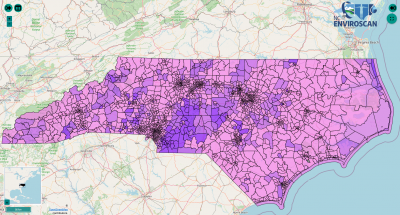UNC researchers develop mapping tool to protect populations from environmental chemicals
February 15, 2022
NC ENVIROSCAN, a new online interactive mapping tool, helps North Carolina communities increase awareness of key environmental and societal factors that can impact health. Developed through a collaboration between the UNC Superfund Research Program (UNC SRP) and the Institute for Environmental Health Solutions (IEHS) in partnership with the Renaissance Computing Institute (RENCI), this tool allows users to visualize trends across the state.

Dr. Rebecca Fry
“NC ENVIROSCAN was developed to provide community members, academic researchers and public health practitioners with a tool to locate areas of concern in N.C. for toxic chemicals, social stressors and disease trends,” said Rebecca Fry, PhD, director of UNC SRP and Carol Remmer Angle Distinguished Professor in Children’s Environmental Health. “It also includes resources to help communities address these challenges.”
Using data from the N.C. Department of Health and Human Services and other federal government sources, the current version of NC ENVIROSCAN illustrates key environmental indicators such as arsenic, cadmium, lead and manganese in water; ozone and particulate matter in air; and other health outcome information, including COVID-19 and preterm birth.

This is a screenshot of a map from NC ENVIROSCAN.
While environmental contaminants can result in negative health outcomes, sociodemographic and environmental justice indicators may also play a role.
Currently, the tool highlights sociodemographic indicators such as poverty, race and ethnicity, and limited English-speaking households. It also includes environmental justice indicators that span respiratory hazards, lead paint, traffic, proximity to treatment storage and disposal facilities, and proximity to wastewater discharge indicators, among others.
This user-friendly tool will increase community awareness of environmental health trends across the state, and researchers are planning to expand NC ENVIROSCAN’s capabilities and usefulness through the addition of new datasets for contaminants such as per-and polyfluoroalkyl substances (PFAS) and health effects like cancer.

Dr. Julia Rager
“We expect this tool to evolve over time and encompass an expansive range of data that can be visualized by researchers and community members alike. It is important to the team that this tool is beneficial for the community, so we included our community partners in every step of the tool’s development process,” said Julia Rager, PhD, co-leader of UNC SRP’s Data Management and Analysis Core and assistant professor of environmental sciences and engineering.
During development, the UNC SRP Community Engagement Core convened community partners and other stakeholders to pilot the tool and provide investigators with feedback on format and content. Suggestions informed its development and identified opportunities for future improvement, including converting the portal into an app for communities with limited access to Wi-Fi.
“It is our hope that NC ENVIROSCAN will promote routes to healthy environments in our state by providing a comprehensive and user-friendly way to view and compare individualized data based on community needs,” Fry concluded.
The tool developers would like to thank the collaborators who made the development of NC ENVIROSCAN possible, including the review and feedback provided by Clean Water for North Carolina, the NC Department of Health and Human Services’ Occupational and Environmental Epidemiology Branch, and the Winyah Rivers Alliance.
Contact the UNC Gillings School of Global Public Health communications team at sphcomm@unc.edu.
